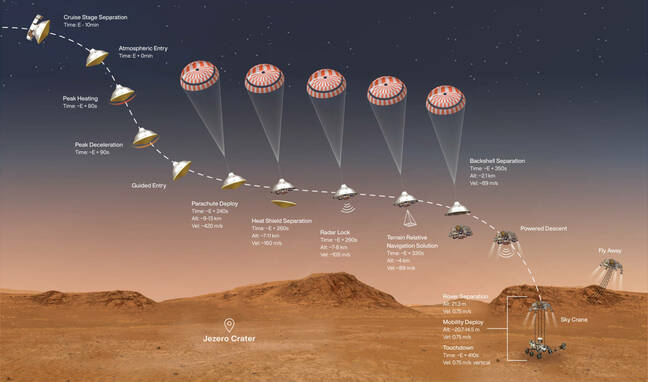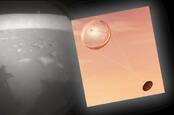This article is more than 1 year old
NASA sends nuclear tank 293 million miles to Mars, misses landing spot by just five metres. Now watch its video
See how plucky Perseverance touched down on the unforgiving dust world
Video NASA successfully landed its fifth robotic rover on the surface of Mars just five metres from its target, the American space agency said after releasing footage of the historic landing.
As Perseverance plunged through the Martian atmosphere and shed its lower shell, its cameras were able to provide scientists with a view of what was going on above and below the vehicle. You can watch the drama unfold below as mission control recounts the various steps needed to slow the rover down from a whopping 5,300 metres per second to plonk it safely on the ground.
Operators applauded and sighed a breath of relief when the parachute opened and Perseverance dangled 15km above ground. The nuclear-powered SUV-sized geology lab-on-wheels arrived on the Martian surface at Jezero Crater, a dried lake bed, on February 18 at about 1555 ET (2055 UTC). It had traveled 292.5 million miles. Landing a robotic rover on Mars is no easy feat; about 50 per cent of all attempts have ended in failure before Perseverance, it's said.
“The riskiest part is the parachute deploy,” Michelle Munk, a systems capability lead for entry, descent, and landing (EDL) at NASA, previously told The Register over the phone.
“That is not something that can be easily modeled. It’s just a piece of fabric that is a little smaller than a baseball field, it’s about 21.5 metres in diameter; all that fabric has to open up symmetrically and evenly in 0.6 seconds faster than the speed of sound on Mars. It’s hard to model how that material will behave, and we can’t test it at full-scale without difficulties here on Earth.”
Al Chen, a systems engineer at NASA JPL’s Entry, Descent, and Landing Systems and Advanced Technologies group, said the parachute weighs about 68kg, and contained two miles of cables that miraculously remained untangled.

Graphical timeline of Perseverance's entry and landing sequence ... Source: NASA/JPL-Caltech. Click to enlarge
The heat shield that protected the rover as it ripped into the Red Planet’s atmosphere is shed, and Perseverance’s cameras are slightly shaky as it rocks back and forth during its descent. Rust-colored dust whirls around on the surface as the rover splits from its parachute and upper shell, and is lowered by the descent stage’s rockets. It is also steered closer to its desired landing point after swerving past its target.
The descent stage then brings the rover down onto the surface using a series of wires in a so-called sky crane maneuver, and it eventually arrives with a gentle thud. The wires are cut and the descent stage can be seen flying away at about three minutes, nine seconds into the video, leaving the rover safely on the Martian landscape.

Hero to Jezero: Perseverance, NASA's most advanced geologist rover, lands on Mars, beams back first pics
READ MORENASA said during a press briefing that the heat shield and parachute crash-landed about 1.5km from Perseverance, and the descent stage 700 metres. All in all, the EDL process went according to plan, although Chen noted that one of eight springs came loose in the heat shield.
Unfortunately, the rover’s microphone was unable to capture any sound during its descent though it did record a ten-second clip of a breeze blowing once on the surface.
“We put the EDL camera system onto the spacecraft not only for the opportunity to gain a better understanding of our spacecraft’s performance during entry, descent, and landing, but also because we wanted to take the public along for the ride of a lifetime – landing on the surface of Mars,” said David Gruel, lead engineer for Mars 2020 Perseverance’s EDL camera and microphone subsystem at JPL.
“We know the public is fascinated with Mars exploration, so we added the EDL Cam microphone to the vehicle because we hoped it could enhance the experience, especially for visually-impaired space fans, and engage and inspire people around the world.”
... closest you can get to landing on Mars without putting on a pressure suit
You may be cheered to hear that various parts of the rover are powered by not just the usual VxWorks but also Linux – such as its autonomous helicopter drone and the computer connected to the EDL cameras [technical briefing PDF]. This camera system runs a customized version of the open-source kernel to max out the data transfer rate between the camera sensors and solid-state storage, and runs FFMPEG to process and compress the imagery. The EDL computer also handles the microphone. [Please, no jokes about the audio not working on Linux, we've suffered enough. – ed.]
"The JPL-developed custom software application layer is comprised of approximately 20,000 lines of code," according to the above technical briefing. "All other functionality is provided by open-source software projects. The total software storage footprint is less than 100 MB. During the seven-minute EDL sequence, the EDLCAM system is expected to generate and store more than 40 GB of camera and microphone data."
Perseverance has snapped more than 20,000 images from its new home so far, some of which have been posted online. Ground control has sent roughly 5,000 commands to the rover to complete as operators continue to check its instruments are working properly. It is expected to take its first weather measurements with its Mars Environmental Dynamics Analyzer, an instrument that studies dust particles, and over the next few days, the Mastcam-Z will capture a 360-degree panorama of Jezero.
Scientists are still figuring out exactly where to direct the 1,025kg six-wheeled plutonium-powered trundlebot in its hunt for ancient microbial life. Ken Williford, the deputy project scientist for the NASA Mars 2020 mission, said that Perseverance had landed on a particular geological feature known as a “contact,” a boundary that separates two different regions of rock.
The Martian surface is littered with light-colored and dark-colored rocks as well as “holey rocks.” Williford is particularly interested to find out if the porous specimens were created from gas escaping volcanic rocks. Scientists have yet not confirmed the presence of igneous rocks; it’s also possible the holes were formed from wind erosion, he added.
Thomas Zurbuchen, the associate administrator for the Science Mission Directorate, said the video was the “closest you can get to landing on Mars without putting on a pressure suit."
"The real work starts now,” he added. “This is science in action.” ®
